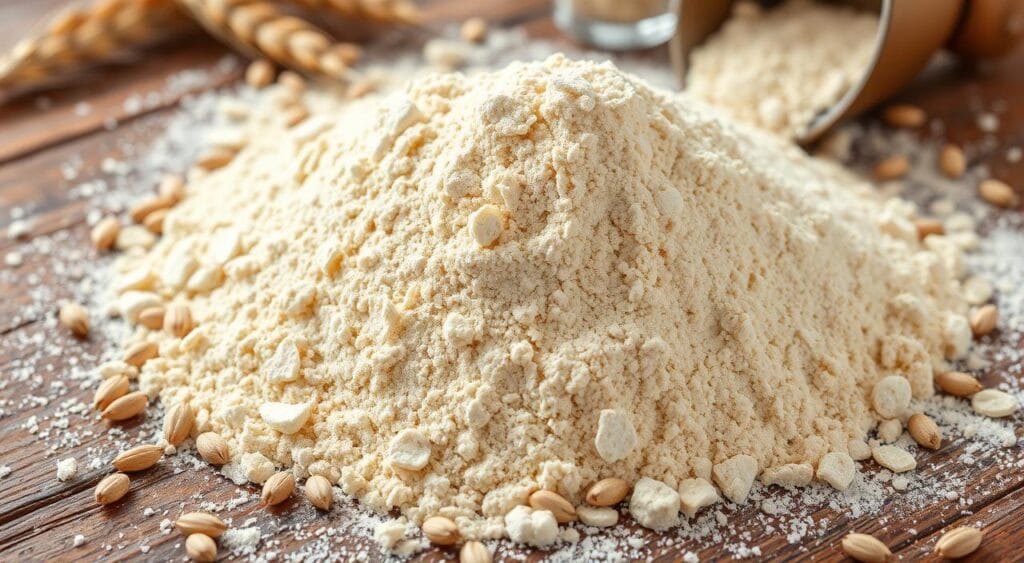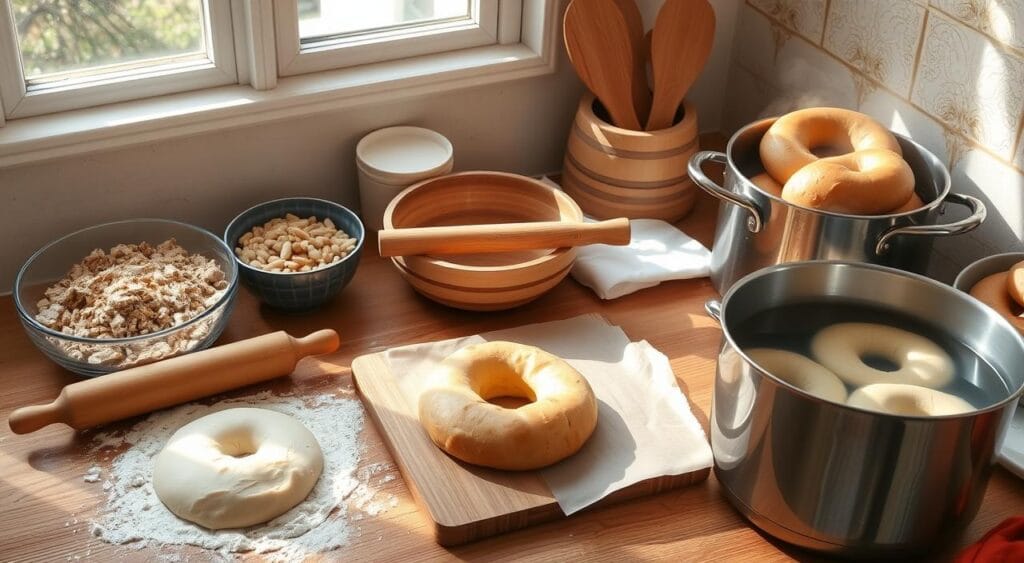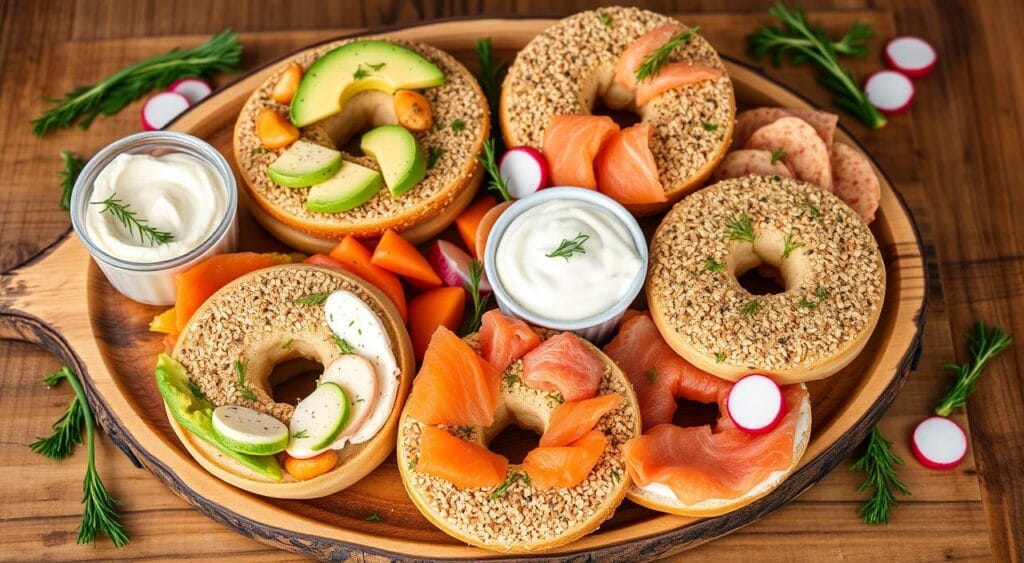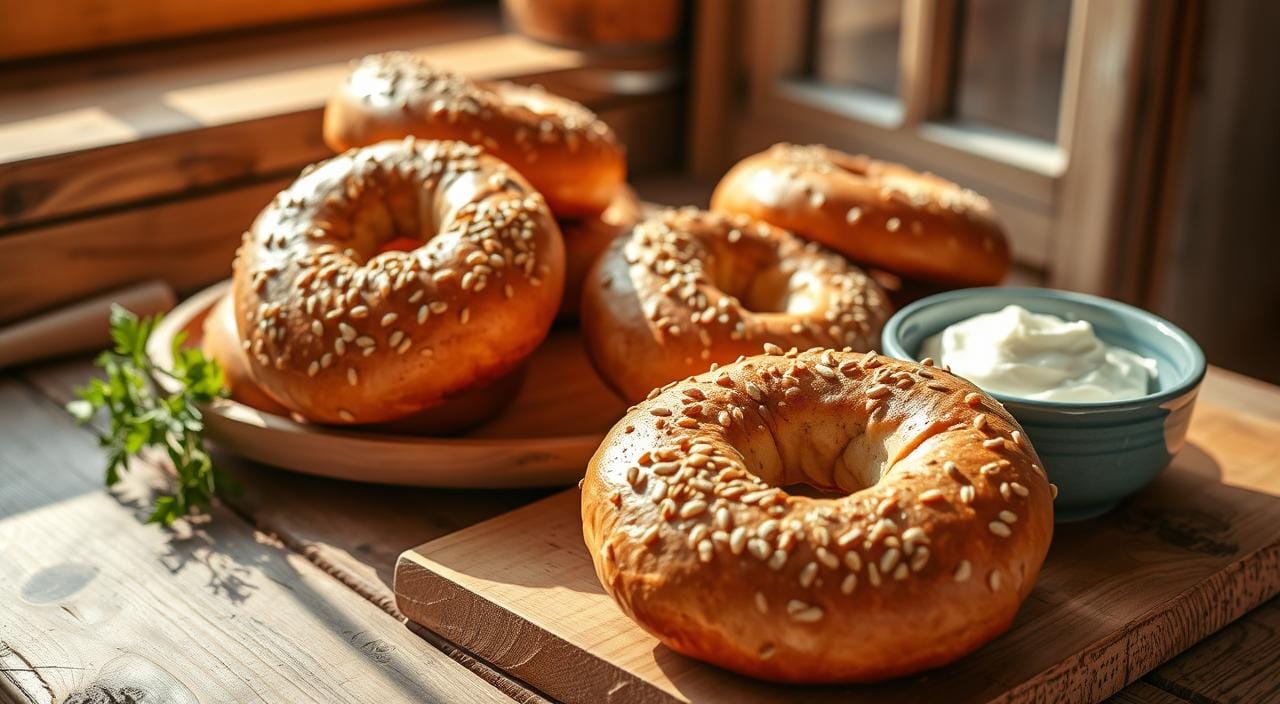Making homemade whole wheat bagels is fun and rewarding. You get to choose what goes into them. This recipe makes 8 bagels, using 4¼ cups of sprouted whole wheat flour or regular whole wheat flour. For a great start, check out a whole wheat bagel recipe online.
Whole wheat flour is key, needing about 510 grams for this recipe. It’s packed with nutrients and tastes great. Add 1¼ teaspoons of instant yeast and 1⅔ cups of water to make the dough. Let it proof for 1½ to 2 hours, then shape and boil your bagels. Bake them at 425 degrees Fahrenheit for 20 to 24 minutes for a crispy crust and soft inside.
Key Takeaways
- Making homemade whole wheat bagels allows for control over ingredients and a fun, rewarding experience.
- A recipe that yields 8 bagels uses approximately 4¼ cups of whole wheat flour and other essential ingredients.
- Whole wheat flour provides a nutritious base for bagels, with about 510 grams required for this recipe.
- The dough proofs for 1½ to 2 hours, resulting in a size increase of about 1½ times.
- Baking the bagels at 425 degrees Fahrenheit for 20 to 24 minutes results in a crispy crust and soft interior.
- Each bagel contains approximately 157 calories, with 33g of carbohydrates, 6g of protein, and 1g of total fat.
- Whole wheat bagels can be stored at room temperature for a few days or frozen for later consumption.
The History and Heritage of Bagels
The bagel history is rich and fascinating, tracing back to Eastern European Jewish culture. The bagel’s earliest form was German pretzel bread, dating to the Middle Ages in Central Europe. It evolved and spread to the United States, becoming a beloved street food.
In Eastern European tradition, bagels were made with whole wheat flour and boiled before baking. This method created their unique chewy inside and crispy outside. Jewish immigrants brought this tradition to the United States, making bagels a staple in cities like New York.
Today, bagels come in many flavors and textures, including whole wheat and everything bagels. The bagel history shows how food can unite people and cross cultural lines. Enjoying a traditional Eastern European-style bagel or a modern twist, you’re part of a rich heritage.
Why Choose Whole Wheat Bagels
Whole wheat bagels are a top pick for healthier options. The 2021 Dietary Guidelines say we should eat 50% whole grains. Whole wheat bagels are full of fiber and have a lower glycemic load than white grains.
Here are some benefits of whole wheat bagels:
- Higher fiber content
- Lower glycemic load
- Nutty, complex flavor
A medium whole wheat bagel has 190 calories, 9 grams of protein, and 55 grams of carbs. It also has 7 grams of sugar and 1 gram of fat. This compares to white bread, which has 67 calories, 2 grams of protein, and 13 grams of carbs.
Whole grains like whole wheat, rye, and sourdough are the healthiest. They have more fiber, which can help you feel full and aid in weight loss. Choosing whole wheat bagels is a healthier choice for a nutritious breakfast or snack.
Essential Ingredients for Perfect Bagels
When making bagels, the right ingredients are key. Whole wheat flour is essential, adding a nutty taste and a denser texture. Choose a fresh, high-quality whole wheat flour for the best results.
Yeast, salt, and sugar are also crucial. They combine to make a delicious, chewy bagel. For a twist, try adding sourdough discard to your bagel making process.

Consider adding seeds, nuts, and dried fruits to your bagels. They bring texture, flavor, and nutrition. Mixing different ingredients lets you create unique, tasty whole wheat bagels for any time.
Required Equipment and Tools
For successful bagel making, you need the right equipment and tools. A kitchen scale helps with precise measurements and is about $40. A stand mixer, like the KitchenAid Professional 600 Series, saves time and is $549.99. You’ll also need a dough-rising container, a large stock pot, a digital thermometer, and a skimmer or spatula.
A list of required equipment and tools includes:
- kitchen scale
- stand mixer
- dough-rising container
- large stock pot
- digital thermometer
- skimmer or spatula
- baking sheets
- baking stone
For more info on bagel making and the needed equipment and tools, check out this website. The right equipment and tools make bagel making fun and rewarding.
Understanding the Science Behind Bagel Making
Bagel science is a complex process. It involves gluten development, fermentation, and boiling. To make the perfect bagel, knowing each part’s role is key. Gluten development is crucial for the bagel’s chewy texture.
This happens when the dough is kneaded. The gluten strands start to form then.
Fermentation is also vital in bagel making. It happens when yeast is added to the dough. This makes the dough rise. The time it takes depends on the temperature and yeast type.
Good fermentation leads to a complex flavor and better texture.
Gluten Development and Fermentation
Gluten development and fermentation are closely linked. As the dough ferments, the gluten strands form more. This gives the bagel its characteristic texture.
The type of flour used affects gluten development. High-protein flour makes a chewier bagel.
The Role of Boiling
Boiling is a key step in bagel making. It gelatinizes the starch and makes the bagel dense and chewy inside. The boiling process also affects the bagel’s texture and color.
The Maillard reaction during baking makes the crust golden-brown. Understanding the science behind bagel making helps create the perfect bagel. This includes gluten development, fermentation, and boiling.
Step-by-Step Bagel Preparation
To make delicious whole wheat bagels, follow a step-by-step process. This includes mixing, kneading, rising, shaping, and baking. With practice, you can make perfect bagels at home.
The first step is mixing the dough. It’s made from whole wheat flour, yeast, sugar, salt, and water. Mix and knead for about 10 minutes until it’s smooth and elastic. Let it rise for 60-90 minutes, or overnight in the fridge.
Next, shape the bagels. Divide the dough into 6-8 pieces. Roll each into a ball and make a hole in the center. Place them on a baking sheet, leaving 3 inches between each.
Before baking, boil the bagels in water for 1-2 minutes on each side. Then, bake at 425°F for 20-25 minutes, or until they’re golden brown. You’ll get a crispy, delicious whole wheat bagel perfect for toast, sandwiches, or snacks.
By following these steps, you can make delicious whole wheat bagels at home. It’s easy and doesn’t cost much. Whether you’re experienced or new to baking, this process works well and gives great results.
The Art of Bagel Shaping
Bagel shaping is key in making bagels. It needs skill and patience for the perfect shape. The traditional way is to roll out the dough into a rope and shape it into a circle. This method makes a classic bagel shape.
Looking for alternative ways to shape? You can use a bagel shaping tool for a uniform shape. Or, shape the dough by hand with rolling and folding.
Success in bagel shaping comes from gentle handling and avoiding over-working. This keeps the dough light and the bagel looks great. For more on bagel making, check out bagel-making resources for tips.
For the perfect shape, use the right dough amount and don’t over-proof. Handle the dough gently. By following these tips, you can make delicious and beautiful bagels.
Proofing and Boiling Process
The proofing and boiling steps are key in making bagels. They help create the chewy inside and crispy outside. The dough should grow by about 50% in volume. A good bagel will float in 10 seconds when it hits boiling water.
For boiling, the water should be between 180-190°F (82-88°C). Water too low won’t gelatinize properly, while water too high can make the bagel tough. Boiling time varies, but usually, it’s 30 seconds per side. Montreal-style bagels boil for 3 minutes each side, while New York-style boil for 30-45 seconds.
For better boiling, keep each bagel 2 inches apart to avoid sticking. Additives like baking soda, honey, and salt can improve flavor and texture. The boiling time changes based on the bagel type. By following these tips, you can make delicious, chewy whole wheat bagels.
Perfect Proofing Conditions
For perfect proofing, control the temperature and humidity. A warm, draft-free spot is best, with a temperature of 75-80°F (24-27°C). Place the dough in a lightly oiled bowl, cover it, and let it rise for 1-2 hours. It should grow by 50% in volume.
Water Bath Secrets
The water bath is crucial for the bagel’s crust and texture. The water should be at the right temperature, and the bagels should boil for the right time. Use additives like baking soda, honey, and salt, and keep each bagel 2 inches apart. These tips will help you make delicious, chewy whole wheat bagels.
Baking Techniques for Professional Results
To get professional results in baking whole wheat bagels, mastering baking techniques is key. Controlling the oven temperature is crucial. It affects the bagels’ texture and crust. A temperature of 450°F is often suggested, but adjust it for your recipe and desired result.
Baking time is also important. Whole wheat bagels need 20-25 minutes in the oven. But, the exact time depends on the bagel’s size and thickness. Professional bakers often use baking and boiling to get the perfect crust.
Some important baking techniques to remember are:
- Using a steamy oven for a crispy crust
- Rotating the bagels halfway for even browning
- Tenting the bagels with foil to avoid overbrowning
By using these techniques, you can make whole wheat bagels as good as those from professional bakeries. Don’t be afraid to try different recipes and baking conditions. This will help you find the perfect taste for you.

Common Troubleshooting Tips
When making whole wheat bagels, several common issues can arise. These issues affect the final product’s texture, shape, and quality. Troubleshooting these problems is crucial to achieve the perfect bagel.
One of the primary concerns is texture problems. These can be caused by underproofing or overproofing the dough.
Another issue is shape problems. These can occur due to improper handling or insufficient gluten development. To address these concerns, it’s essential to understand the importance of gluten development.
Achieving proper gluten development typically requires over 20 minutes with a stand mixer. It can take up to 30 minutes or more while kneading by hand.
Texture Problems
Texture problems can be caused by various factors. Underproofing can lead to a dense and rough texture. Overproofing can result in a soft and airy texture.
To resolve these issues, it’s crucial to monitor the proofing time. Adjust it according to the recipe and environmental conditions.
Shape Issues
Shape issues can occur due to improper handling or insufficient gluten development. To address these concerns, it’s essential to handle the dough gently. Avoid overworking it.
Ensuring proper gluten development can help maintain the bagel’s shape and structure.
By following these troubleshooting tips, you can improve your whole wheat bagel-making skills. Remember to always monitor your dough’s progress. Adjust your techniques as needed.
Practice patience and persistence to overcome any challenges that may arise during the troubleshooting process.
Storing and Freezing Your Homemade Bagels
There are many ways to keep homemade bagels fresh for longer. Fresh bagels can be stored in an air-tight container for a short time. But, they can get stale fast because of their hole in the middle.
For homemade bagels to stay fresh, keep them in a cool, dry spot. Sliced bagels can be frozen and still taste great. They can stay in the freezer for up to three months. Freezing them sliced makes it easy to thaw only what you need.
Here are some tips for storing and freezing bagels:
- Use an old-fashioned bread box to store fresh bagels
- Moisten frozen whole bagels with water before toasting
- Store sliced bagels in a way that keeps air out
By using these tips, you can enjoy your homemade bagels for longer. Whether you store them at room temperature or freeze them, keeping them fresh is key. With the right storing and freezing methods, you can enjoy your homemade bagels whenever you like.
Creative Serving Suggestions
There are countless ways to serve whole wheat bagels. You can go for classic toppings or try something new. Favorites include cream cheese with smoked salmon or deli meats with cheese.
For a fresh twist, try bagels with unique toppings like hummus, avocado, or egg salad. These add exciting flavors to the traditional bagel. You can also make sandwiches with turkey, roast beef, or veggies on whole wheat bagels.
Some favorite ways to serve bagels include:
- Bagel bars with many toppings, great for parties
- Breakfasts with scrambled eggs, bacon, and cheese
- Bagels with soups like creamy broccoli cheese or tomato bisque

These ideas can make whole wheat bagels even more enjoyable. Whether you prefer something classic or modern, there’s a way to serve them that’s sure to delight.
Nutritional Benefits of Whole Wheat Bagels
Whole wheat bagels are a healthier option for breakfast or snacks. They have more fiber, vitamins, and minerals than regular bagels. A medium-sized whole wheat bagel has about 4 grams of fiber. This helps with digestion and keeps you feeling full.
Some key benefits of whole wheat bagels include:
- Higher fiber content: Whole wheat bagels have more fiber than regular bagels. This supports digestive health and keeps you full.
- Essential vitamins and minerals: They are rich in iron, potassium, and calcium.
- Lower calorie count: Whole wheat bagels have fewer calories than regular bagels. This makes them a good choice for those watching their weight.
The American Heart Association says eating three whole grains a day can lower heart disease risk. Whole wheat bagels are a tasty way to add more whole grains to your diet. You can top them with cream cheese, avocado, or eggs for a nutritious meal.
Eating whole wheat bagels can help lower the risk of heart disease, type 2 diabetes, and some cancers. They are packed with fiber, vitamins, and minerals, and are lower in calories. So, they’re a great choice for a healthier diet.
Variations and Flavor Combinations
Whole wheat bagels are great for mixing and matching flavor combinations. You can try everything from classic sesame to everything bagels. Check out types of bagels for inspiration.
Some favorites include cinnamon raisin, blueberry, and asiago. Pair these with cream cheese or cottage cheese for a tasty snack. For more cottage cheese ideas, visit cottage cheese recipes.
With whole wheat bagels, you can get creative. Add herbs, spices, or nuts to make something special. Here are a few ideas:
- Sesame and poppy seeds for a nutty taste
- Dried fruits like cranberries or cherries for sweetness
- Chopped nuts, such as walnuts or almonds, for crunch
Remember, the fun is in experimenting. Try new things and find your favorite variations of whole wheat bagels.
Conclusion
As we wrap up our exploration of whole wheat bagels, making them from scratch is truly rewarding. From mixing ingredients to baking them golden, it’s a joy. These bagels are not just healthier but also add a special flavor and texture to any meal.
Whether you’re an experienced baker or just starting, making homemade whole wheat bagels is easy. With some practice, you can enjoy the freshness and quality of these treats at home. Remember, the fun is in the making, not just the eating.
FAQ
What are the benefits of making homemade whole wheat bagels?
Making your own whole wheat bagels lets you pick the ingredients. This makes for a healthier and more enjoyable breakfast or snack. Plus, it’s fun to make something yourself.
What is the history and heritage of bagels?
Bagels started in Eastern European Jewish culture. Over time, their shape and making process changed. Now, whole wheat bagels offer a healthier twist on the classic.
Why should I choose whole wheat bagels over traditional ones?
Whole wheat bagels have more fiber and fewer calories. This makes them a better choice than regular bagels.
What are the essential ingredients for making perfect whole wheat bagels?
You’ll need whole wheat flour, yeast, salt, and optional toppings. These add flavor and texture to your bagels.
What equipment and tools are required for making whole wheat bagels?
You’ll need a mixing bowl, measuring tools, a baking sheet, and an oven. These are key for baking your bagels.
How does the science behind bagel making work?
Making bagels involves gluten, fermentation, and boiling. These steps make them chewy and crusty.
What is the step-by-step process for preparing whole wheat bagels?
First, mix the dough. Then, shape the bagels. Next, proof and boil them. Finally, bake to perfection.
How do I shape whole wheat bagels?
Use the ring method or try other shapes. This helps get the right texture and look for your bagels.
Why is proofing and boiling important in the bagel-making process?
Proofing and boiling make the dough chewy and crusty. They’re key steps in making great bagels.
What baking techniques can help me achieve professional results with whole wheat bagels?
Control oven temperature and baking time. Avoid common mistakes to improve your bagels’ taste and texture.
How can I troubleshoot common problems when making whole wheat bagels?
Identify and fix texture, shape, and crust issues. This will help you make better bagels.
How do I store and freeze my homemade whole wheat bagels?
Store them in airtight containers. Freezing is also good for keeping them fresh and tasty.
What are some creative ways to serve whole wheat bagels?
Try new toppings and pairings. This can make your bagels even more enjoyable.
What are the nutritional benefits of whole wheat bagels?
They have more fiber, fewer calories, and important vitamins and minerals. This makes them a healthier option.
What are some variations and flavor combinations for whole wheat bagels?
Add herbs, spices, or nuts to create unique flavors. This can make your bagels even more delicious.

